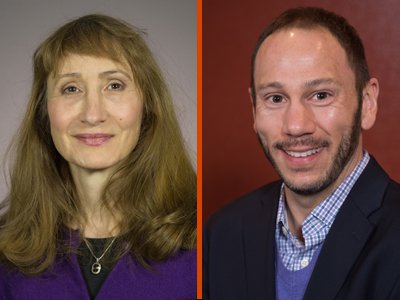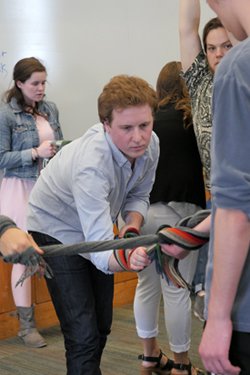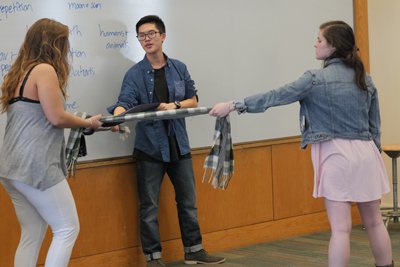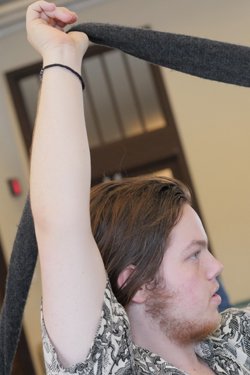Performing Religion
Religion and theater professors co-teach interdisciplinary course

Kathleen Baum began a recent Performing Religion (REL 300) class with a simple direction: “Take a walk,” she told the 15 students. She continued speaking as the students walked up and down the stairs and through rows of green seats in Room 132 in Lyman Hall. “Find a tempo,” Baum said. “Allow a leader to emerge. It doesn’t have to be an intellectual decision. When you allow it to, it happens.”
The chattering quickly stopped as students concentrated, synchronizing steps and forming a line. Baum then directed students to call out destinations and match their movements and demeanors to the location. They slowed as they headed to an imaginary funeral, smiled and picked up their pace on the way to the moon, and sped up as they approached a finishing line.
Baum, an acting instructor in the College of Visual and Performing Arts’ Department of Drama, and William Robert associate professor of religion in the College of Arts and Sciences, co-teach this unusual interdisciplinary course, which combines humanistic and artistic approaches to religion and performance. The Lava Project employs a similar interdisciplinary collaboration between sculptor Bob Wysocki of the Department of Art and geologist Jeff Karson of the Earth Sciences Department.

After the movement exercise, students caught their breath as they wrote about their experience. “Don’t think; just write,” Robert told them. After a spirited exchange about whether the professors or students controlled the game, Robert transitioned to the day’s reading assignment. The discussion addressed such questions as: Can a performance be repeated? Or is it ephemeral? How does an audience change a performance? How is performing in live theater different from performing in a movie? How is the viewing experience different for the two forms? Is spectating itself a kind of performance? In what way is a performance a ritual?
The course begins with the premise that religion is a performance, Robert says: “It’s not a set of beliefs. It’s not a set of sacred texts. What does that mean about the way we think about religion?” The syllabus includes theoretical texts and two plays: Sophocles’ ancient Greek tragedy “Antigone” and Bess Wohl’s “Small Mouth Sounds,” which played two acclaimed Off-Broadway engagements and will begin a national tour this fall.

Robert and Baum began creating the course last May, bringing to the task their individual expertise and appreciation for the other’s perspective and experience. Baum is an actor, coach and teacher who has worked in theaters and training programs in Melbourne, Sydney, Sao Paolo, Toronto, London and Berlin, and on both U.S. coasts. Robert teaches and writes about philosophy of religion, ancient Greek and medieval Christian religions, religion and literature, and methods in religious studies. He is author of “Revivals: Of Antigone” (SUNY Press, 2015) and “Trials: Of Antigone and Jesus” (Fordham University Press, 2010).
Performing Religion “is not only a transmission of information or expertise to the students, it’s an invitation to explore by physically embodying an idea or question,” Baum says.
“Instead of only reading ritual theory, the bodily performance becomes the text,” Robert adds.

Performance, according to the class syllabus, is “a tool to enhance critical reading, thinking, writing and speaking skills.” In addition to guided performance exercises, students presented “performance responses” to readings and discussions. The class of 15 includes three drama majors, but students with no theater experience have been open to the class’s challenges, the professors say.
The non-traditional approach to discussing religion is new for the professors, as well. “I will never teach ritual in the same way,” Robert says. “Using these exercises makes the point so much better. It gets students engaged. The classroom is more like a lab.”
Baum, too, is learning from the course. “It’s changed my own thinking about religion, ritual and performance,” she says. She praises the students’ willingness to be vulnerable. “They’re being challenged in this way that’s radically different,” she says. “They’re rising to the challenge.”
